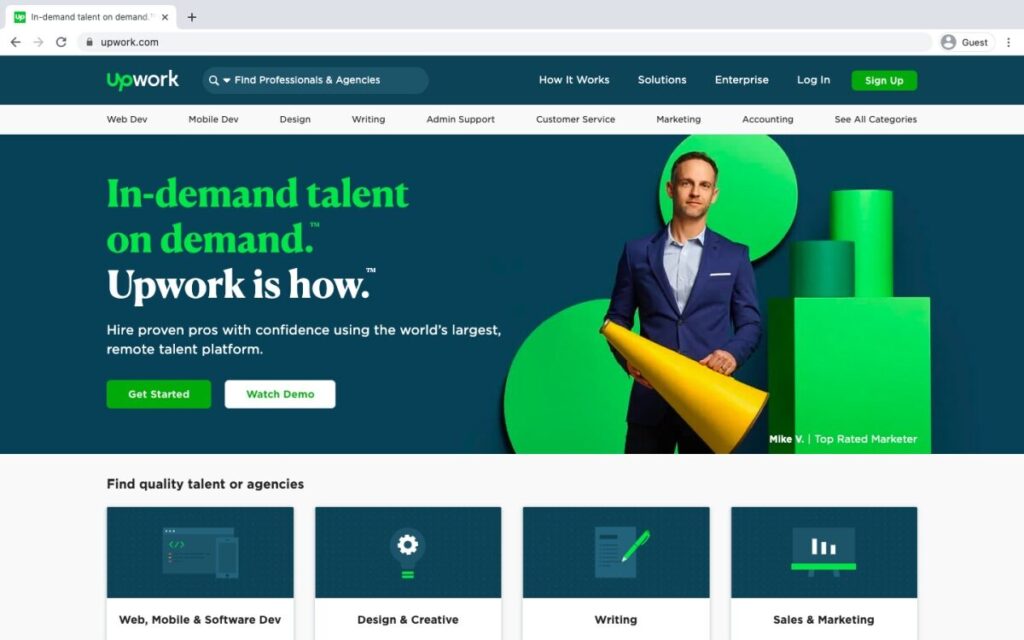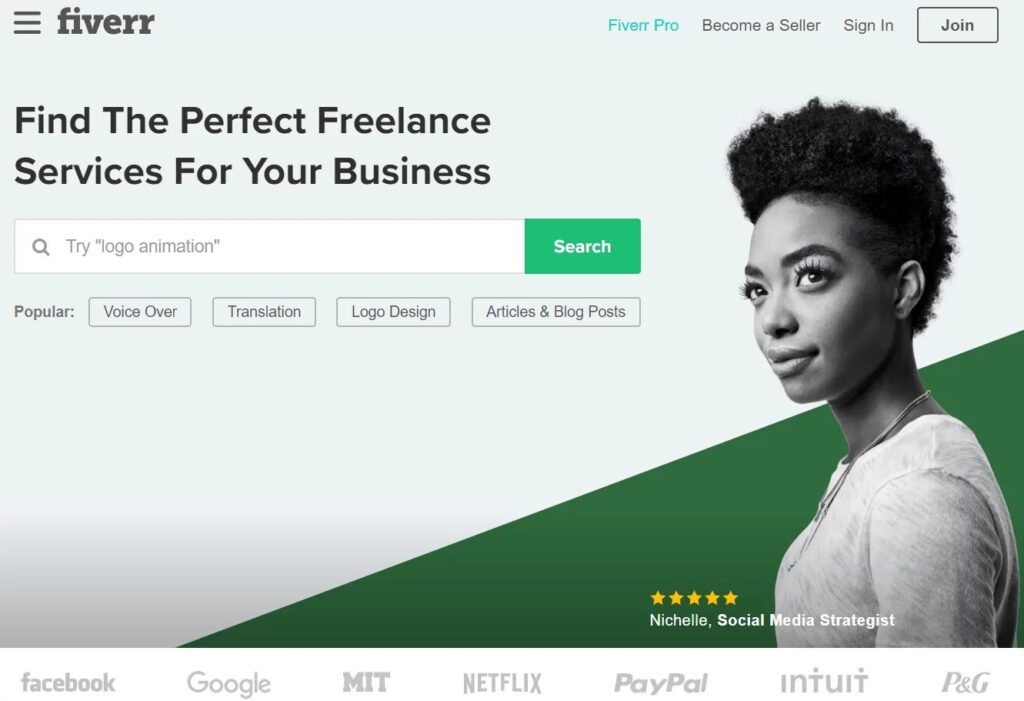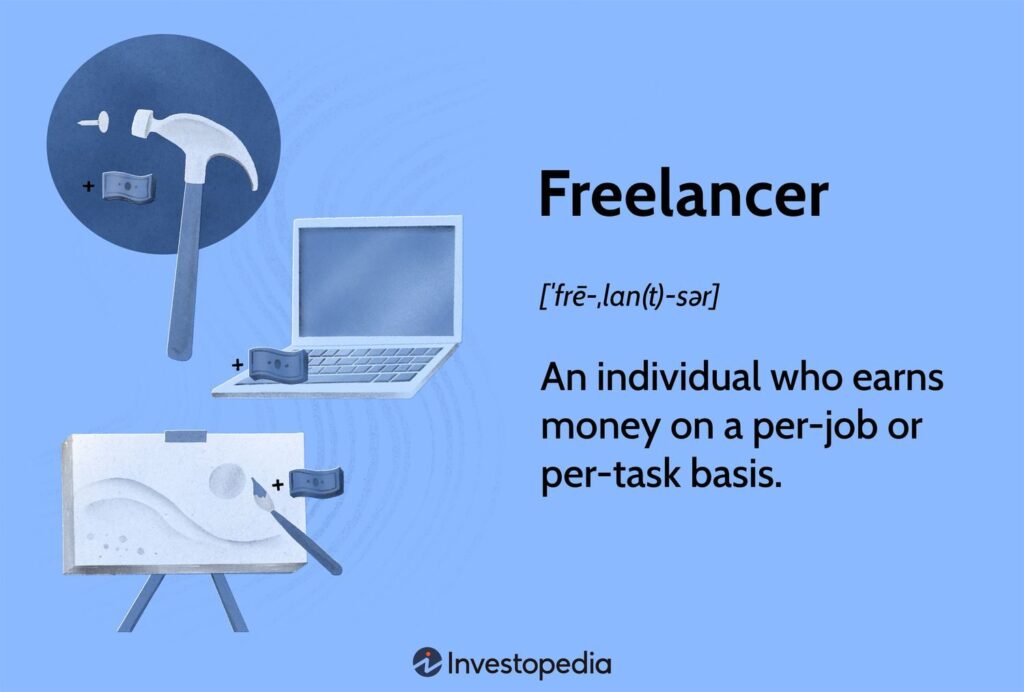While specific sites might change over time, here’s a breakdown of different categories of online money-making platforms to consider in 2024:
These are 10 Online Making – Money Sites In 2024 known to me.
Freelancing
Upwork

Upwork is a popular online freelancing platform that connects freelancers with businesses all over the world. It functions like a marketplace where you (the freelancer) can showcase your skills and experience, and businesses (clients) can post jobs searching for qualified individuals.
Here’s a deeper dive into Upwork:
What Upwork Offers Freelancers:
- Find Work: Browse a vast pool of job postings in various fields like writing, editing, web development, graphic design, marketing, and virtual assistance.
- Showcase Your Skills: Create a compelling profile highlighting your skills, experience, and portfolio to attract clients.
- Set Your Rates: Decide on your hourly rate or project-based pricing for your services.
- Secure Payment: Upwork acts as a secure escrow service, holding client funds until you complete the project and get approval.
- Build Your Reputation: Earn positive client reviews and build a strong reputation to attract better projects in the future.
What Upwork Offers Clients:
- Find Top Talent: Access a wide pool of skilled freelancers across various industries and skillsets.
- Post Jobs: Clearly define your project requirements and budget to attract qualified candidates.
- Review Freelancers: Browse profiles, portfolios, and reviews to find the perfect fit for your needs.
- Secure Communication & Collaboration: Upwork provides tools for secure communication and project management with your chosen freelancer.
- Safe Transactions: Ensure secure payments through Upwork’s escrow service.
Upwork’s Fee Structure:
Upwork charges freelancers a service fee based on their total earnings per project. The fee typically ranges from 5% to 20%, with lower fees for higher total project earnings within a specific timeframe.
Getting Started with Upwork:
- Create an Account: Signing up is free and involves setting up your profile.
- Build Your Profile: This is your chance to shine! Highlight your skills, experience, education, and any relevant certifications.
- Browse Jobs: Search for projects that align with your skills and interests.
- Submit Proposals: Craft compelling proposals showcasing your qualifications and why you’re the ideal fit for the job.
- Connect with Clients: Communicate effectively, negotiate rates, and build strong client relationships.
Here are some additional things to consider about Upwork:
- Competition: The freelance market can be competitive. Focus on creating a strong profile and competitive rates to stand out.
- Client Reviews: Building a positive client review history is crucial for attracting future projects.
- Communication is Key: Maintain clear and consistent communication with clients to ensure project success.
- Time Management: Freelancing requires strong time management skills to meet deadlines and manage multiple projects if necessary.
Upwork can be a great platform to launch or grow your freelance career. By effectively utilizing its features and building a strong reputation, you can connect with clients and build a successful online business.
Fiverr

Fiverr is an online marketplace specifically designed for offering and finding freelance services in bite-sized, pre-priced packages called “Gigs.” Unlike Upwork’s project-based or hourly rates, Fiverr sellers (called “Sellers”) list their services at specific prices, often starting at $5 (though prices can go much higher).
What Fiverr Offers Sellers:
- Standardized Services: Create Gigs outlining your services, deliverables, and pricing for a clear value proposition.
- Attract Clients: Showcase your skills and experience to a broad audience of potential clients searching for specific services.
- Fast Transactions: Receive payment upfront once a buyer purchases your Gig.
- Build a Portfolio: Every completed Gig adds to your profile, building trust and credibility with potential clients.
- Global Marketplace: Reach clients from all over the world, expanding your potential customer base.
What Fiverr Offers Buyers:
- Simple & Convenient: Easily find pre-priced services without the hassle of negotiating rates or project scopes.
- Variety of Services: Browse through a vast selection of Gigs across various categories like writing, graphic design, video editing, social media marketing, and more.
- Clear Pricing: Know exactly what you’ll pay upfront for each Gig, ensuring budget clarity.
- Seller Reviews: Read reviews from previous buyers to assess seller credibility and service quality.
- Secure Transactions: Fiverr provides secure payment processing for a safe buying experience.
Things to Consider about Fiverr:
- Standardized Services: Gigs need to be clearly defined beforehand, offering less flexibility for complex projects.
- Competition: The platform can be competitive, so creating attractive Gigs and competitive pricing is crucial.
- Price Variation: While some Gigs start at $5, complex services can cost significantly more. Be clear on pricing and deliverables.
- Focus on Specific Skills: Fiverr shines for well-defined skills and services. Open-ended projects might be less suitable.
Who Should Use Fiverr?
Fiverr is a great platform for:
- Freelancers offering well-defined services: Graphic designers, writers, social media managers, and translators can effectively showcase their skills in pre-defined packages.
- Clients seeking specific, bite-sized tasks: Tasks like logo design, video editing, or social media post creation can be easily found and purchased on Fiverr.
Upwork vs. Fiverr:
While both Upwork and Fiverr connect freelancers with clients, they cater to slightly different needs. Upwork is more project-based, allowing for flexible pricing and negotiation. Fiverr focuses on pre-defined services with clear pricing for simple and quick transactions.
The Takeaway:
Fiverr provides a unique platform for freelancers to offer specific skills and services at set prices. It’s a great way to find clients and build a freelance business, especially for those offering well-defined, easily packaged tasks.
Freelancer

Freelancer.com is another major player in the online freelancing world, offering a platform for businesses to find freelancers for various projects. Here’s a breakdown of what it can offer you:
For Freelancers:
- Project Marketplace: Browse a wide range of projects posted by businesses in numerous fields like writing, programming, design, marketing, and administrative tasks.
- Showcase Your Skills: Create a profile highlighting your expertise, experience, and portfolio to attract potential clients.
- Bidding System: Compete with other freelancers by submitting bids that outline your proposed approach, timeline, and pricing for the project.
- Secure Payment: Freelancer.com acts as an escrow service, holding client funds until the project is completed and approved.
- Build Your Reputation: Earn positive client feedback and build a strong reputation to attract better projects in the future.
For Businesses (Clients):
- Access to Talent: Find skilled freelancers across various industries and skillsets to fill specific project needs.
- Post Projects: Clearly define your project requirements and budget to attract qualified freelancers.
- Review Proposals: Evaluate bids from freelancers, comparing their qualifications, proposed approach, and pricing.
- Secure Communication & Collaboration: Freelancer.com provides tools for secure communication and project management with your chosen freelancer.
- Safe Transactions: Ensure secure payments through Freelancer.com’s escrow service.
Freelancer.com’s Fee Structure:
Similar to Upwork, Freelancer.com charges freelancers a service fee based on their total project earnings. The fee typically ranges from a percentage (around 0% to 10%) to a fixed fee, depending on the project type and membership level.
Getting Started with Freelancer.com
- Create an Account: Signing up is free and involves setting up your profile.
- Build Your Profile: This is your chance to shine! Highlight your skills, experience, education, and any relevant certifications.
- Browse Projects: Search for projects that align with your skills and interests.
- Submit Bids: Craft compelling proposals showcasing your qualifications and why you’re the ideal fit for the job.
- Connect with Clients: Communicate effectively, negotiate rates, and build strong client relationships.
Here are some additional things to consider about Freelancer.com
- Competition: The freelance market can be competitive. Focus on creating a strong profile and competitive bids to stand out.
- Client Reviews: Building a positive client review history is crucial for attracting future projects.
- Communication is Key: Maintain clear and consistent communication with clients to ensure project success.
- Project Scope: Carefully review project details and requirements before submitting bids to avoid scope creep.
Similarities and Differences with Upwork & Fiverr:
Freelancer.com shares some similarities with Upwork, like project-based work and bidding systems. However, it also caters to project contests, where businesses can choose the best freelancer from multiple submissions. Compared to Fiverr’s focus on pre-priced packages, Freelancer.com offers more flexibility in pricing through bids.
The Takeaway:
Freelancer.com provides a broad platform for freelancers to find projects and for businesses to access a global talent pool. By building a strong profile, submitting competitive bids, and effectively communicating with clients, you can leverage this platform to build a successful freelance career.
Content Creation Platforms
Content creation platforms have become a launchpad for many aspiring online earners and businesses. They provide a space to showcase your creativity, build an audience, and potentially earn money through various methods. Here’s a breakdown of some popular content creation platforms and what they offer:
1. Video-focused platforms:

- YouTube: The granddaddy of online video sharing, YouTube allows you to upload various video formats, from short vlogs to feature-length documentaries. You can earn through advertising, sponsorships, affiliate marketing, or your own merchandise.
Pros: Massive audience reach, potential for high engagement, diverse content formats.
Cons: Competition can be fierce, ad revenue can be inconsistent for smaller channels, requires good video editing skills.
- Twitch: Primarily focused on live streaming gameplay, creative content, or interactive sessions. You can earn through subscriptions, donations (bits), or brand sponsorships.
Pros: Real-time interaction with your audience, strong community focus for specific niches (gaming, art, etc.).
Cons: Requires consistent streaming schedule, may not be suitable for all content types, revenue heavily reliant on audience engagement.
2. Text-focused platforms:
- Medium: A publishing platform for articles, stories, and poems. You can potentially earn money through their Partner Program, which rewards creators based on reader engagement (claps, follows, reading time).
Pros: Established audience interested in long-form content, good platform for writers and bloggers, potential for community building.
Cons: Earning potential can be slow and depend heavily on audience growth, limited content formats compared to video platforms.
- Blogs (self-hosted or platform-based): Offer a high degree of customization and control over your content. You can earn through advertising, affiliate marketing, selling your own products or courses, or subscriptions.
Pros: Flexibility and control over content and monetization, potential for building a niche audience, can establish yourself as an authority in your field.
Cons: Requires technical knowledge for self-hosted blogs, building an audience takes time and consistent effort, competition is high in many niches.
3. Audio-focused platforms
- Podcasts: A rapidly growing medium for sharing audio content like interviews, discussions, or storytelling. You can earn through advertising, sponsorships, listener donations (crowdfunding platforms like Patreon), or selling merchandise.
Pros: Intimate and engaging format, location-independent creation (record remotely), potential for niche audience growth.
Cons: Building an audience takes time and promotion, editing audio can have a learning curve, requires good audio quality for a professional feel.
Choosing the right platform:
Consider your content format, target audience, and desired monetization methods when choosing a platform. Look for platforms that align with your content style and offer features and tools to support your creative process.
Additional Tips:
- Focus on quality content: Creating valuable and engaging content is key to attracting and retaining an audience.
- Be consistent: Regularly publish content to build momentum and keep your audience coming back for more.
- Promote your content: Share your content on social media, collaborate with other creators, and explore online communities to reach a wider audience.
- Monetization strategies: Don’t solely rely on one income stream. Explore various monetization options that complement your content and audience.
Remember, building a successful online presence takes time and dedication. By choosing the right platform, creating high-quality content, and consistently engaging with your audience, you can turn your passion for content creation into a thriving online venture.
- YouTube: Build a following by creating engaging videos and monetize through ads, sponsorships, or affiliate marketing.
- Twitch: Focus on live streaming gameplay, creative content, or interactive sessions. Earn through subscriptions, donations, or bits (Twitch’s virtual currency).
- Medium: Publish articles, stories, or poems and potentially earn money through their Partner Program based on reader engagement.
Online Stores& Marketplace
Etsy

Etsy is an American e-commerce website focused on handmade or vintage items and craft supplies. Founded in 2005, Etsy has become a go-to online marketplace for unique and creative products. Here’s a deeper dive into what Etsy offers:
What can you find on Etsy?
- Handmade Goods: From jewelry and clothing to home décor and furniture, Etsy is a treasure trove for handcrafted items made by artisans worldwide.
- Vintage Finds: If you have a taste for the past, you’ll love Etsy’s vast selection of vintage items, including clothing, accessories, furniture, and home décor, all at least 20 years old.
- Craft Supplies: Unleash your creativity with Etsy’s extensive collection of craft supplies, from beads and yarn to sewing notions and painting tools.
Who can benefit from Etsy?
- Shoppers: Looking for unique gifts, one-of-a-kind home decor, or vintage treasures? Etsy is a great place to find something special that you won’t see on store shelves.
- Sellers (Crafters & Vintage Curators): If you’re a maker, crafter, or vintage collector, Etsy provides a platform to showcase and sell your creations to a global audience.
Benefits of Selling on Etsy:
- Reach a Global Market: List your products and connect with millions of potential customers worldwide.
- Set Your Own Prices: Maintain control over your pricing strategy and profit margins.
- Build Your Brand: Create a shop storefront to showcase your unique style and brand identity.
- Seller Tools & Community: Etsy offers a suite of tools to manage your shop, marketing, and customer communication. You’ll also be part of a supportive community of sellers.
Things to Consider When Selling on Etsy:
- Shop Setup & Fees: There are listing fees, transaction fees, and payment processing fees associated with selling on Etsy.
- Competition: The handmade and vintage market is competitive. Crafting high-quality products, taking compelling photos, and offering excellent customer service are crucial for success.
- Marketing Your Shop: Actively promote your Etsy shop on social media, through online advertising, or by participating in online craft communities.
Here are some additional tips for a successful Etsy shop:
- High-Quality Photos: Showcase your products with professional-looking photos that capture their details and beauty.
- Detailed Descriptions: Provide clear and informative descriptions that highlight the materials, dimensions, and any other relevant details about your products.
- Excellent Customer Service: Respond promptly to inquiries, be helpful and courteous, and strive to provide a positive customer experience.
Overall, Etsy is a vibrant online marketplace that connects creative buyers and sellers worldwide. Whether you’re searching for unique gifts, one-of-a-kind crafts, or vintage treasures, or you’re a crafter or vintage collector looking to sell your creations, Etsy offers a platform to fulfill your creative desires.
Shopify

Shopify is a leading e-commerce platform that empowers individuals and businesses to set up and manage their online stores. It provides a comprehensive solution, from creating your storefront to managing products, payments, and shipping. Here’s a closer look at what Shopify offers:
What Can You Do With Shopify?
- Create Your Online Store: Shopify offers a user-friendly interface with drag-and-drop functionalities, allowing you to build your online store without any coding knowledge. Choose from a variety of customizable themes to create a visually appealing and brand-consistent storefront.
- Manage Products: Easily add, edit, and manage your product information, including descriptions, pricing, inventory levels, and high-quality images.
- Payment Processing: Shopify integrates with various payment gateways, allowing you to securely accept credit cards, debit cards, and other online payment methods from your customers.
- Shipping & Fulfillment: Manage your shipping options, set shipping rates, and integrate with fulfillment services if needed. Shopify also offers its own fulfillment network, Shopify Fulfillment Network (SFN), for an additional fee.
- Marketing & Sales Tools: Shopify provides built-in marketing and sales tools to help you promote your store and reach new customers. You can run email marketing campaigns, create discount codes, and leverage social media integrations.
- App Store: Extend the functionality of your store with a vast app store offering thousands of apps developed by Shopify and third-party developers. You can find apps for various needs, such as accounting, email marketing, customer loyalty programs, and more.
Benefits of Using Shopify
- Easy to Use: Even if you’re not tech-savvy, Shopify’s user-friendly interface makes it easy to create and manage your online store.
- Scalability: Shopify can accommodate businesses of all sizes, from startups to established brands. You can upgrade your plan as your business grows.
- Security & Reliability: Shopify takes security seriously and provides a reliable platform to host your online store.
- App Store: The vast app store allows you to customize your store’s functionality and add features to meet your specific needs.
- Multiple Sales Channels: Sell your products not just through your online store, but also integrate with other channels like social media platforms and marketplaces.
Things to Consider When Using Shopify
- Monthly Fees: Shopify has different pricing plans with varying features and transaction fees. Choose a plan that suits your business needs and budget.
- Transaction Fees: Shopify charges a transaction fee for each sale made through their platform, though some plans offer lower fees.
- App Costs: While there’s a free app selection, many valuable apps have additional costs, which can add up depending on your needs.
Shopify vs. Other Options
- Pros over competitors: Ease of use, scalability, extensive app store, secure platform.
- Cons to consider: Monthly fees and transaction fees can add up, some features require additional apps (potentially increasing costs).
Who Should Use Shopify?
Shopify is a great option for a wide range of businesses and individuals looking to sell online. It’s suitable for:
- Entrepreneurs: Starting an online business with minimal technical knowledge.
- Established Businesses: Expanding their reach with an online presence alongside their physical store.
- Crafters & Artists: Selling their handmade creations and reaching a wider audience.
- Anyone with a product to sell: From physical goods to digital products like ebooks or printables.
Overall, Shopify provides a user-friendly and feature-rich platform to create and manage your online store. With its scalability and extensive app store, it can cater to businesses of all sizes. However, be mindful of the monthly fees, transaction fees, and potential app costs when making your decision.
Amazon Marketplace

Amazon Marketplace is a giant in the world of online retail, offering a platform for third-party sellers to list and sell their products alongside Amazon’s own offerings. It’s essentially a marketplace within a marketplace, giving you a vast audience to reach and potentially boost your sales. Here’s a breakdown of what Amazon Marketplace offers:
Who Can Benefit?
- Sellers: Businesses or individuals can leverage Amazon’s established customer base and infrastructure to sell new or used products across various categories.
- Buyers: Customers enjoy a massive selection of products from various sellers, often with competitive prices and fast fulfillment options thanks to Amazon’s reach.
What Can You Sell on Amazon Marketplace?
- Wide Variety: The marketplace encompasses a vast array of categories, from electronics and home goods to clothing, books, and even groceries.
- New & Used: Sell new, refurbished, or used products, depending on your inventory and business model.
Benefits of Selling on Amazon Marketplace:
- Reach a Massive Audience: Tap into Amazon’s millions of active customers, significantly increasing your potential market reach.
- Fulfillment Options: Choose between fulfilling orders yourself (Fulfillment by Merchant – FBM) or leveraging Amazon’s fulfillment centers (Fulfillment by Amazon – FBA) for a more hands-off approach (additional fees apply).
- Brand Building: Create a seller account with your branding and product listings, allowing you to establish brand recognition alongside sales.
- Marketing & Advertising Tools: Utilize Amazon’s advertising tools to reach targeted audiences and increase product visibility within the marketplace.
Things to Consider Before Selling on Amazon Marketplace
- Fees: There are various fees associated with selling on Amazon, including listing fees, referral fees (percentage of your selling price), and fulfillment fees (if using FBA).
- Competition: The marketplace is highly competitive. Optimizing your listings, pricing competitively, and offering excellent customer service are crucial for standing out.
- Regulations: Amazon has strict product listing guidelines and seller performance expectations. Ensure you comply with their policies to avoid account suspension.
Here are some additional tips for success on Amazon Marketplace
- High-Quality Product Listings: Use clear and professional product photos, detailed descriptions, and optimize your listings with relevant keywords for better search ranking.
- Competitive Pricing: Research and adjust your pricing to be competitive within the marketplace while maintaining your profit margins.
- Customer Service: Provide excellent customer service to build trust and positive reviews, which can significantly impact your sales.
Overall, Amazon Marketplace offers a powerful platform for businesses and individuals to expand their online reach and sales potential. However, it requires careful planning, understanding the fees involved, and a commitment to product quality, competitive pricing, and exceptional customer service.
Microtasking & Survey Sites
Prolific

Prolific is a crowdsourcing platform specifically designed for research purposes. Unlike some other survey sites that might offer rewards for watching videos or shopping online, Prolific focuses on connecting researchers with participants to gather valuable data for academic studies, market research, and user experience testing. Here’s a deeper dive into what Prolific offers:
Who Uses Prolific?
- Researchers: Academics, universities, and market research firms use Prolific to recruit participants for their studies. They can target specific demographics or criteria to ensure they get relevant data.
- Participants: People like you who sign up to participate in research studies and share their opinions and experiences in exchange for a fair reward.
What Makes Prolific Different?
- Focus on Research: Prolific prioritizes high-quality research data, ensuring participants engage with well-designed studies conducted by reputable institutions.
- Ethical Approach: The platform emphasizes ethical research practices and fair compensation for participants’ time and effort.
- Pre-screening: Researchers can set specific criteria for participants, and you’ll only see studies that align with your profile, saving you time on irrelevant surveys.
- Detailed Study Information: Before participating, you can see clear details about each study, including the estimated time commitment, reward amount, and research topic.
- Faster Payouts: Compared to some other survey sites, Prolific is known for faster processing and payouts to participants.
How to Earn on Prolific:
- Sign Up: Create a free account and complete your profile with your demographics and interests.
- Browse Studies: The platform displays studies that potentially match your profile.
- Pre-screening Questions: Each study might have additional screening questions to confirm your eligibility for that specific research.
- Complete the Study: If you qualify and decide to participate, follow the study’s instructions and complete the tasks or answer the questions honestly.
- Receive Payment: Once you complete the study and it’s approved by the researcher, you’ll receive the promised reward in your Prolific account.
Things to Consider with Prolific:
- Study Availability: The number of available studies can vary depending on your profile and location. Researchers might target specific demographics for their studies.
- Time Commitment: While some studies are quick, others might require a longer time investment. Be sure to check the estimated time before participating.
- Reward Amounts: Rewards vary depending on the study’s complexity and length. They might be lower compared to some general survey sites, but Prolific prioritizes fair compensation for research participation.
Is Prolific Right for You?
If you’re interested in contributing to research and sharing your opinions for a good cause, while potentially earning some extra income, Prolific can be a great platform. It offers a more focused and ethically sound approach to online surveys compared to some general reward sites. Just remember, the earning potential might be moderate and depend on study availability.
Here’s a helpful tip: To maximize your chances of finding relevant studies, keep your profile information up-to-date and be honest when answering pre-screening questions. Researchers rely on accurate data, and responsible participation benefits everyone involved.
Conclusion
- These are just a few examples, and many other platforms exist. Research and compare before committing.
- Success varies depending on your effort, skills, and chosen platform.
- Always be cautious of scams and unrealistic earning promises.
Focus on building high-quality content, services, or products on the platform you choose. Consistency and a genuine desire to offer value are key to attracting clients and building a sustainable online income stream.
FAQs
- What are the best online money-making sites?
There’s no single “best” site, as it depends on your skills, interests, and time commitment.
- How much money can I make with these sites?
Earning potential varies greatly. Microtasks and surveys typically pay small amounts per task/survey. Freelancing and content creation can be lucrative, but require effort to build a client base or audience. E-commerce success depends on your product, marketing strategy, and competition.
- Is it possible to make a full-time income online?
Yes, it’s possible, but it often takes time, dedication, and consistent effort. Many online money-making options are better suited for generating extra income or a side hustle.
You May Also Like
- How to Make Money Online as a Teen : Unlocking the Digital Frontier
- How to Make Money Online as A Teen: A Comprehensive Guide
- How to Make Money Singing From Home


